 Image search results - "japanshrine" Image search results - "japanshrine" |

Yasukuni Shrine's main torii during Mitama Matsuri
|
|

Torii on Takeshima island
|
|

Torii at Umamioka Watamuki Shrine in Hino, Shiga Pref.
|
|

Haritsuna Shrine
|
|

Sanko Inari ShrineThe shrine provides a short cut to the castle.
|
|

Karatsu Shrine
|
|

Tokiwa Shrine, MitoDedicated to Lord Mitsukuni Tokugawa, the second lord of Mito, and Nariaki Tokugawa, the ninth lord of Mito and the one who built Kairakuen Garden.
|
|

Chichibu Shrine
|
|

Coming down from Yomeimon Gate (National Treasure). 陽明門The gate is a National Treasure and symbol of Nikko.
陽明門
|
|

Standing room only at Wakamiya Shrine
|
|

Oarai Isosaki Shrine's giant torii
|
|

Passing under the torii at Futarasan Shrine. 二荒山神社二荒山神社
|
|

Tagata Shrine Honden main hall. Komaki, Aichi Pref.
|
|

Yasukuni Shrine, Torii and Haiden hall
|
|

Oarai Isosaki Shrine torii at sea
|
|

Yasukuni Shrine, Haiden hall. After the Class-A war criminals (such as Hideki Tojo) were enshrined here, the late Emperor Hirohito (Showa) never worshipped here again. 拝殿
|
|

Isosaki Shrine's second giant torii
|
|

Meoto-Iwa Wedded Rocks off the coast of Futami-cho, Ise city, Mie Prefecture. 夫婦岩
|
|

The Wedded Rocks are part of Futami Okitama Shrine known for frog sculptures. 二見興玉神社
|
|

The shrine is dedicated to Sarutahiko and Ukano-mitama. Sarutahiko is a god which serves as a pathfinder guide. Deities for land/sea transportation safety. 二見�
|
|

Isosaki Shrine
|
|

Two of the portable shrines ready to go. In Japanese, the festival is nicknamed "Chinko Matsuri" (Phallus Festival) ちんこ祭り.There are three portable shrines (called mikoshi). The Kanamara mikoshi (the original portable shrine), Kanamara-bune mikoshi (shaped like a boat), and Elizabeth mikoshi (pink giant). All three are carried during a procession around town. The Elizabeth mikoshi is carried by she-males. ("New half" in Japanese. Go ahead and laugh if you want.)
|
|

Futami Okitama Shrine does not have a main hall (Honden) like most other shrines. It worships the Okitama Sacred Stone in the ocean beyond the Wedded Rocks. 二見興玉神社
|
|

Money pit
|
|

Tenjin Shrine, reconstructing the shrine. Ryuo-cho, Shiga. 天神社
|
|

Who says money can't buy happiness?
|
|

Wakamiya Hachimangu Shrine
|
|

Straw ring and Hie Jinja Shrine's Shaden Worship Hall. 社殿
|
|

Kanayama Shrine (right next to Wakamiya Hachimangu)Kanayama Shrine is dedicated to a pair of gods named Kanayama Hikonokami and Kanayama Himenokami 金山比古神(かなやまひこのかみ) 金山比売神(かなやまひめのかみ. According to legend, when the main Shinto god named Izanami gave birth to the God of Fire, her lower abdomen got burned. These two Kanayama gods helped to heal her birth wound. Thus, these two gods came to be known as the gods of childbirth and healing of the lower abdomen. They later came to be worshipped as fertility gods, protector of sexually-transmitted diseases (AIDS, etc.), and successful marriage. They are also the gods of the bellows, so blacksmiths (who use bellows to fan the fire) also worship this shrine.
Kanayama Shrine is a small shrine within the grounds of the larger Wakamiya Hachimangu Shrine. The Kanayama Shrine was completely rebuilt and reborn in 1999 into a completely unorthodox building which you see here. Modeled after a blacksmith's workshop, it is now a black, eight-sided building with steel paneling. Notice the penis monument on the lower right.
|
|

Toka Ebisu, Imamiya Ebisu Shrine, Osaka
|
|

Even gaijin shrine maidens decorate bamboo branches or rakes. Toka Ebisu, Imamiya Ebisu Shrine, Osaka
|
|

The old Kanayama ShrinePicture was taken in the 1980s.
|
|

The old Kanayama Shrine
|
|

The old Kanayama Shrine
|
|

Aoshima Shrine torii and Devil's Washboard, Miyazaki
|
|

Aoshima Shrine, Miyazaki
|
|

Azaleas and torii gates, Nezu Shrine
|
|

Musashi-Mitake Shrine, Tokyo 武蔵御嶽神社
|
|

Osakabe Shrine on top floor of Himeji Castle. This shrine was already on the hill before the castle was built. The shrine was moved when the castle was built, but it was brought into the castle after some "curses" occurred.
|
|

Back at the shrine
|
|

Warriors and Five-story Pagoda
|
|

Naotaka Shrine, dedicated to Lord Ii Naotaka, the third lord of Hikone Castle. 直孝神社
|
|

Shirahige Shrine torii, Takashima. One of Lake Biwa's best-known landmarks. It faces the shrine on land. Rent a bicycle or go by taxi from Omi-Takashima Station (Kosei Line).
|
|

Hogonji's Shinto shrine has this iconic torii facing the lake. You can buy small clay dishes to throw at the torii. If your dish goes through the torii, your wish will come through. However, most dishes never make it through the torii. They litter the ground.
|
|

I visited Fushimi Inari Taisha Shrine on Jan. 1, 2010. At the Kyoto City Tourist Info office, I asked which shrine was Kyoto's most popular on New Year's Day. They told me it was this shrine, so I came here.
|
|

Fushimi Inari Taisha, Kyoto. Inch by inch, we crept toward the main shrine on New Year's Day.
|
|

All you hear are these bells ringing overhead.
|
|

Entrance to the hiking trail of torii gates, what Fushimi Inari Shrine is famous for.
|
|

Inside the tunnel of toriis at Fushimi Inari Shrine in Kyoto, all donated to the shrine by companies.
|
|

Fox at Fushimi Inari Shrine.
|
|

Now I'm going down the mountain. You can then see the writings on the back of the toriis. The name of the company and date are written. Of course, donating a torii here is no guarantee for business success. Some of these companies have gone bankrupt.
|
|

Fujisan Hongu Sengen Taisha Shrine's second torii has a fine view of Mt. Fuji.
|
|

People pray for Good health, good job, prosperity, good school, good marriage partner (even though fewer people are getting married in Japan), etc.
|
|

Offertory box in front of the main shrine. That's money on the floor.
|
|

The high structure is the main shrine (Honden) standing 13 meters high. Built in 1604 by Tokugawa Ieyasu. In the distinctive sengen-zukuri style.
|
|

Eastern torii of Fujisan Hongu Sengen Taisha Shrine has a great view of Mt. Fuji.
|
|

Eastern torii of Fujisan Hongu Sengen Taisha Shrine has a great view of Mt. Fuji.
|
|

Eastern torii of Fujisan Hongu Sengen Taisha Shrine has a great view of Mt. Fuji.
|
|

At Sengen Taisha Shrine in Fujinomiya.
|
|
|

Hakone Shrine
|
|

Hakone Shrine's torii you see from the pirate boat on Lake Ashi looks tiny, but it's actually a giant torii of Hakone Shrine.
|
|

Comparable to the torii at Miyajima in Hiroshima. Not doubt one of the most photographed in Japan.
|
|

About 100 meters offshore are two large rocks in the lake. They appear above the surface only when there is a water shortage. This little shrine with two rocks are for praying for rain. 二ツ石
|
|

Hiyoshi Taisha's Nishi Hongu Honden Hall, a National Treasure. It is only one of three buildings in Japan which represent the Hie-zukuri (日吉造り) architectural style. Higashi Hongu and Usagu and the two other shrines in this style.西本宮 �
|
|

Secondary shrines
|
|

Koyurugi Shrine
|
|

Mimusubi Shrine, Yotsukaido, Chiba. The small shrine that conducts the festival. (皇産霊神社)
|
|
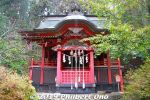
Kita-Ibaraki's Hanazono Shrine was patronized by the Tokugawa shoguns. It features the flamboyant architectural style called "gongen-zukuri" (権現造) with colorful, intricate wood carvings on shrine buildings. It's similar to the famous Toshogu Shrine in Nikko (Tochigi) dedicated to Ieyasu. Toshogu in Nikko is famous for the three monkeys: "see no evil, hear no evil, speak no evil." 本殿
|
|

Hanazono Shrine also has a version of the three monkeys here on the Honden shrine hall, but only half the mouth, only one ear, and only one eye are covered as you can see here.
|
|

Ise Jingu Shrine's Naiku (Inner Shrine) is the main and most popular shrine at Ise. The shrine is rebuilt every 20 years and 2013 will mark the completion of the new shrine to replace the old one built in 1993.
|
|

The bottleneck at Naiku was this little torii which most people wanted to walk through at the top of the steps. People like me who didn't have time opted to go up the steps on the right side in no time.
|
|

High walls prevent us from seeing the sacred shrine buildings of Naiku. Photography is not allowed inside these walls so don't try to use a long pole with a camera attached to take pictures. There are guards everywhere.
|
|

Roof horns at Ise Jingu's Naiku.
|
|

It takes 8 years to rebuild the Naiku shrine. So 12 years from now, they will start the rebuilding process all over again. Numerous ceremonies are held for this rebuilding, but only a few of them can be seen by the public.
|
|

Geku Outer Shrine at Ise Jingu.
|
|
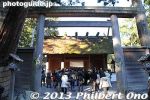
Entering Geku shrine at Ise.
|
|

Look how small the offertory box is at Geku.
|
|
|

Collecting coins.
|
|

Collecting coins at Taka-no-miya Shrine 多賀宮.
|
|

On New Year's Day 2018, many people visit Izumo Taisha Shrine by car. Lots of parking was provided, but I always saw the "Full" sign.
|
|

This center path is reserved for the gods visiting Izumo Taisha. Humans have to walk on the side paths to the shrine. 参道
|
|

Izumo Taisha's Honden built in the Taisha-zukuri style. National Treasure. 本殿
|
|

Izumo Taisha's Honden, a National Treasure. The V-shaped roof ornaments (chigi), an unmistakable trademark of Shinto, also look slightly different from other shrine architectural styles.
|
|

Izumo Taisha's Kaguraden with the iconic giant shimenawa sacred rope weighing 5 tons. Built in 1981. 神楽殿と注連縄
|
|

Giant shimenawa straw rope of Izumo Taisha Shrine's Kaguraden, the largest sacred rope in Japan. Weighs 5 tons.
|
|
|

Kotohira Shrine has this unique affiliate shrine named "Kishima Shrine" (木島神社) which is the left half of this building. (The right-half shrine is Sarutahiko Shrine [猿田彦神社] for the god of transportation and directions.)Kishima Shrine is unique in Japan for these two koma-neko cat guardians. Shrines usually have koma-inu lion-dog guardians (to ward off evil spirits), but only this shrine in all of Japan has cat guardians instead.
|
|
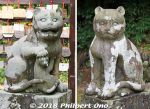
Kishima Shrine has koma-neko cat guardians because silk farmers in the 19th century kept cats to protect their precious silkworms and cocoons from rats. Rats were a major problem for the silk industry.They ate the silk cocoons and worms. So cats saved the local silk industry.
The left cat is the mother (holding a kitten), and right cat is the father. Also respectively "A" and "un."
These koma-neko cat guardian statues were donated in 1832 by silk merchants and wholesalers such as the Tonomura family (外村家一族、岩滝のちりめん問屋、山家屋の小室利七) who were textile merchants from Higashi-Omi (Gokasho), Shiga Prefecture.狛猫
|
|

Kyoto Ebisu Shrine on its busiest day of the year.
|
|

As people ring the bell and pray for prosperity amid the current recession, the shrine rakes in the money on its most important day of the year, Jan. 10.
|
|

Tagi Daimyojin-no-Miya Shrine is dedicated to the water god, for protection against floods. Long ago, nearby rivers often flooded this area. 龍樹大明神宮
|
|

Kehi Shrine's torii is 11 m high. One of Japan's three most famous wooden toriis. The other two being Miyajima's Itsukushima Shrine in Hiroshima Pref. and Kasuga Shrine in Nara.
|
|

Kehi Jingu's main shrine. Kehi Jingu is dedicated to a number of gods including Emperor Chuai and Empress Jingu. So the Imperial Crest is all over the place.
|
|

Gate to Yasaka Shrine. The shrine also holds the annual Gion Matsuri Festival in July featuring ornate floats paraded around the city.
|
|

Yasaka Shrine's Honden Hall.
|
|

Musashino Hachimangu Shrine in Kichijoji. 武蔵野八幡宮
|
|

That's why most Tenmangu/Tenjin shrines have plum blossoms. Kameido Tenjin Shrine flanked with red and white plum blossoms in March.
|
|

Photogenic shot of plum blossoms and a taiko bridge at Kameido Tenjin Shrine in Tokyo.
|
|

The right side of the worship hall is also lined with plum blossoms at Kameido Tenjin Shrine.
|
|
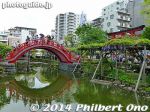
The first taiko bridge at Kameido Tenjin Shrine, Tokyo
|
|
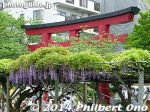
Torii and wisteria at Kameido Tenjin Shrine, Tokyo
|
|

Kameido Tenjin Shrine torii and taiko bridge with wisteria.
|
|

Kameido Tenjin Shrine, Tokyo
|
|

Stone lanterns leading to Kasuga Taisha Shrine.
|
|

Kasuga Taisha Shrine bright vermillion color contrasts with the dark brown tones of nearby Buddhist temples.
|
|

Kasuga Taisha Shrine is also noted for many bronze hanging lanterns.
|
|

Kamosu Shrine in Matsue, Shimane. 神魂神社
|
|

Yaegaki Shrine, Matsue 八重垣神社
|
|

Mikami Shrine's Honden in Yasu, a National Treasure. It is a mixture of Shinto shrine and Buddhist temple architecture. It dates from the Kamakura Period, about 700 years ago. 本殿
|
|

Mikami Jinja's Honden. This was Shiga's first Shinto shrine building to be designated as a National Treasure. 本殿
|
|

One of Japan's Scenic Trio (Nihon Sankei), the famous torii with Miyajima island in the background.
|
|

Main torii of Itsukushima Shrine and perhaps Japan's most famous and iconic torii.
|
|

I visited Itsukushima at high tide in the morning so the shrine was floating.
|
|
|

Itsukushima shrine
|
|

Najima torii off the Morito Coast on the Miura Peninsula in Kanagawa Prefecture. Part of Morito Daimyojin Shrine. 名島(菜島)の鳥居
|
|

Meiji Shrine's main worship hall. If you look closely at the wooden pillars, you can see numerous little cuts in the wood made by people throwing coins at the shrine during New Year's.
|
|

Two wedded tree trunks (楠) coupled by a sacred rope at Meiji Shrine.
|
|

Meiji Shrine is also popular for holding weddings. On weekends, you can see several couples passing through.
|
|

New Year's Day at Meiji Shrine. A total of 3 million people give New Year's prayers (Hatsumode) at Meiji Shrine. Japan's most popular shrine during New Year's.
|
|

Money in the offertory pit on New Year's Day at Meiji Shrine.
|
|

Meiji Shrine's torii.
|
|

Mishima Taisha Shrine in Shizuoka Pref. This is the main torii. Townsend Harris, US consul to Japan, visited here when he was on his way to Tokyo from Shimoda.
|
|

Mishima Taisha Shrine Honden is an Important Cultural Property.
|
|

Mishima Taisha Shrine roof
|
|

Namura Shrine's Romon Gate, Ryuo, Shiga. Important Cultural Property.
|
|

In the center is Namura Shrine's Nishi Honden hall, a National Treasure. On the left is Hachiman Shrine, an Important Cultural Property. I could finally see this building directly. Ryuo, Shiga.
|
|

Near Naha's beach, Naminoue Shrine (波上宮). Major Shinto shrine in Naha. Looks very Okinawan. http://naminouegu.jp/english.html
|
|
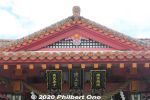
Naminoue Shrine roof.
|
|

Honden Hall of Kunozan Toshogu Shrine at Nihondaira, Shizuoka. The shrine's focal point and most magnificent building. Important Cultural Property.
|
|

The shrine looks spanking new and the colors are very impressive. It cost 1,300,000,000 yen to restore the lacquer and paint.
|
|

Tokugawa Ieyasu's tomb at Kunozan Toshogu
|
|

Something unique is this upside down kadomatsu decoration flanking Nishinomiya Shrine's Haiden Hall.
|
|

Tanashi Shrine is dedicated to Ookuni Nushi-no-Mikoto. 大国主命(おおくにぬしのみこと)in Nishi-Tokyo, Tokyo.
|
|

Sumiyoshi Shrine in Ome, Tokyo
|
|

Hikawa Shrine torii points the way to the shrine. Omiya, Saitama
|
|

Hikawa Shrine gate, Omiya, Saitama 楼門
|
|

Otori Taisha shrine's Haiden worship hall on New Year's Day 2019, Sakai, Osaka. 拝殿
|
|

Otori Taisha shrine suffered major damage from Typhoon No. 21 in Sept.2018. Part of the roof on the main shrine was damaged.
|
|

Osasahara Shrine's Honden Hall, a National Treasure in Yasu, Shiga. The shrine dates from the mid-Heian Period. It is dedicated to a god named Susano-o. 大笹原神社 本殿
|
|

Honden main hall of Shinagawa Shrine, one of Shinagawa Ward's major shrines. Dedicated to Amenohirinome-no-Mikoto, Susano-o-no-Mikoto, and Uganome-no-Mikoto. Near Shin-Bamba Station North Exit on the Keihin Kyuko Line from Shinagawa Station.
|
|

Sorihashi Bridge (反橋) is a symbol of the shrine and one of the larger taikobashi.
|
|

Sumiyoshi Taisha's Hongu No. 1 shrine, a National Treasure. Osaka city. Worships Sokotsutsu no Onomikoto (底筒男命).
|
|

Sumiyoshi Taisha Hongu No. 2 shrine, National Treasure. Worships Nakatsutsu no Onomikoto (中筒男命). (第二本宮)
|
|

Rear view of Hongu No. 3 and No. 4 shrines. Sumiyoshi-zukuri architecture
|
|

Wakamiya Hachimangu Shrine, a secondary shrine of Sumiyoshi Taisha. The torii is unusual with the middle beam not sticking out the sides. 若宮八幡宮
|
|

Wakamiya Hachimangu Shrine, a secondary shrine of Sumiyoshi Taisha. Worships Hachiman (Emperor Ojin), the guardian deity of the samurai. 若宮八幡宮Hachiman (Emperor Ojin) was the son of Empress Jingu.
|
|

Nankun-sha cat shrine (楠珺社).
|
|

Nankun-sha cat shrine altar (楠珺社). It promotes "Hattatsu" worship. At Sumiyoshi Taisha, Osaka. 初辰まいりYou supposed to come here and worship monthly and collect a total of 48 cat figurines over a period of 24 years. Then you'll get the jackpot of family safety and business prosperity. It's based on a play of words with "48" (shijuhachi) that can be pronounced similarly to "shiju-hattatsu (始終発達) which means "constant advancement or development."
|
|

Tiny beckoning cat figurines at Nankun-sha cat shrine at Sumiyoshi Taisha.
|
|

Larger beckoning cat figurines at Nankun-sha cat shrine at Sumiyoshi Taisha.
|
|

Shimoniikawa Shrine worships a god named Toyoki-iribiko-no-Mikoto who was the first son of Emperor Sujin 崇神天皇, Japan's tenth emperor. 豊城入彦命
|
|

Taga Taisha Shrine, Shiga. Taga Taisha rethatched its roof and celebrated with a festival in Oct. 2007.
|
|

Tomioka Hachimangu Shrine, Honden worship hall. Koto-ku, Tokyo 富岡八幡宮 本殿
|
|

Dankazura path to Tsurugaoka Hachimangu Shrine.
|
|

In the forefront is the Maiden sacred dance stage and the rear is the Hongu main worship hall.
|
|

Hongu main worship hall at Tsurugaoka Hachimangu Shrine. The left side of the Hongu is a small museum. 本宮
|
|

Wakamiya Shrine, Tsurugaoka Hachimangu Shrine's only building that is an Important Cultural Property. 若宮
|
|

Taga Matsuri is held annually on April 22 at Taga Taisha Shrine. It's basically a procession of Shinto priests, children in costume, women warriors, and other people on 40 horses. These photos were taken in 2009.
|
|

Hokoku Shrine, Nagahama, Shiga
|
|

Ukishima Benzaiten Shrine in Tataranuma Park, Tatebayashi, Gunma. Part of the spirit of Benzaiten at Enoshima island in Kanagawa was transferred here. 浮島弁財天
|
|

Taikodani Inari Jinja Shrine's many toriis going up the mountain.
|
|

Taikodani Inari Jinja Shrine toriis
|
|
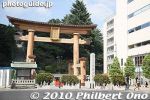
Futaraasan Shrine in Utsunomiya.
|
|

Yushima Tenjin Shrine was one of Hiroshige's "100 Views of Edo" ukiyoe primt series. Honden main hall during the Chrysanthemum Festival in Nov. Bunkyo- Ward, Tokyo.
|
|

Torii of Kobiyoshi Shrine and giant torches in the distance, Ryuo, Shiga Prefecture.
|
|
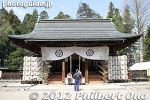
Uesugi Shrine, Yonezawa, Yamagata
|
|

Zaiji Hachiman Shrine, the family shrine of the Todo clan. This place in Zaiji (Kora, Shiga) was Lord Todo Takatora's birthplace. Takatora later became lord of Tsu Castle in Mie Prefecture. MAP
|
|

Torii gate to Zaiji Hachiman Shrine in Kora, Shiga.
|
|
|
|
|